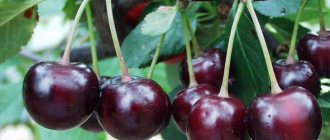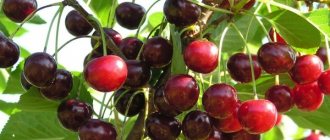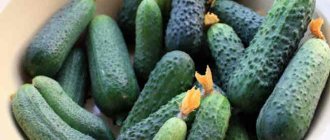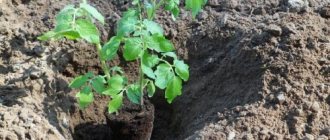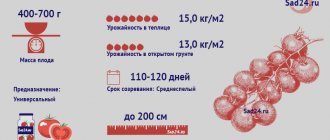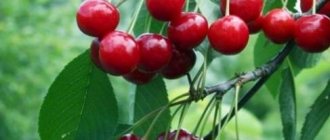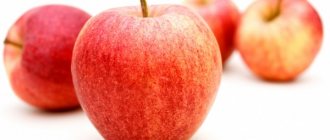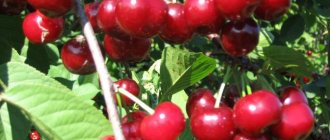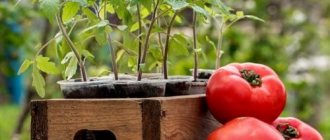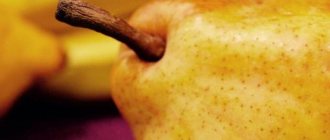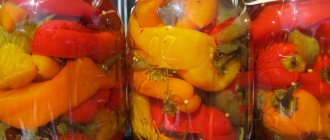Common cherry 'Lebedyanskaya'
Latin name: prunus cerasus 'lebedyanskaya'
Main species: Common cherry
| Fruit size |
|
| Fruit shape |
|
| Fruit color | |
| Winter hardiness |
|
| Decoration of plants and fruits |
|
| Flower size |
|
| Brush characteristics |
|
| Berry/truss separation |
|
| Nut kernel size |
|
| Blush (cover color) |
|
| Fruit pulp color | |
| Density and character of the pulp (fruit/bush/yag) |
|
| Fruit aroma |
|
| Frost resistance (fruit/bush/yag) |
|
| Drought resistance (fruit/bush/yag) |
|
| Beginning of fruiting after planting |
|
| Ripening period (fruit/bush/yar) |
|
| Consumer maturity |
|
| Productivity (fruit/bush/yag) |
|
| Fruit shedding |
|
| Remontant |
|
| Self-pollinating/self-fertile |
|
| Purpose of fruits (fruit/bush/yag) |
|
| Taste of fruits (fruit/bush/yag) |
|
| Soil pH requirements (fruit/bush/yag) |
|
| Shelter for the winter (fruit/bush/yag) |
|
| Soil type (fruit/bush/yar) |
|
| Disease resistance (fruit/bush/yag) |
|
| Resistance to pests (fruit/bush/yag) |
|
| Habitus (fruit/bush/yag) |
|
| Growth form |
|
| Crown density |
|
| Thorns, thorns |
|
| Vitamin content (fruit/bush/yag) |
|
| Keeping quality of fruits (fruit/bush/yag) |
|
| Cultivation region by origin (fruit/bush/yar) |
|
Expand all properties
Description of the plant:
Common cherry 'Lebedyanskaya' is a seedling from free pollination of the 'Vladimirskaya' variety, treated with the chemical mutagen EI (0.1%) at the seedling stage. Obtained from the All-Russian Research Institute of Horticulture named after. I.V. Michurin in 1976. Accepted for state variety testing in 1990.
Recommended for testing in the Central Black Earth region.
Dimensions and growth form:
Common cherry 'Lebedyanskaya' is represented by medium-sized trees. The crown is pyramidal, raised, of medium density.
Flowers and fruits:
The fruits are below medium to medium size, 3.4 g, oval-heart-shaped. The skin is dark red, of medium thickness. The stalk is easily separated from the branch.
The pulp is red, juicy, tender, relatively dense. The taste is very good, sweet and sour.
Precocity, ripening time, yield:
The variety is not early fruiting, table, self-sterile. Medium ripening period. Productivity is average, annual.
Winter hardiness:
Disease resistance:
The variety Common Cherry 'Lebedyanskaya' is moderately resistant to diseases and pests.
Cherry Chocolate Girl
The variety was bred at the end of the 20th century. The fruits are burgundy. This is a small tree. Its height is no more than 2.5 m. The combination of branches and leaves form a pyramidal shape.
The plant looks more like a shrub than a tree. Produces many fruits. The flowers are painted white.
Blooms in May. Cherries ripen in July. But the timing may vary in different regions. They taste sweetish, slightly sour.
Cherry "Lebedyanskaya": characteristics and description
Cherry Lebedyanskaya has been known since 1990; scientists from the Institute of Horticulture I.V. Michurina worked on its creation. The main goal was to obtain an ideal variety for the Black Earth zone. The variety has a lot of positive qualities, but its main highlights are its productivity, large fruit and excellent taste.
Lebedyanskaya was obtained from the seed of the Vladimirskaya cherry, at a certain stage of growth it was treated with the EC mutagen, let's find out what came out of it.
Lebedyanskaya cherry variety
Morozovka is a mid-season cherry bred at the All-Russian Research Institute of Horticulture named after. I.V. Michurin from Vladimirskaya seed (the seedling was treated with the chemical mutagen ethyleneimine (GH2) 2NH at a concentration of 0.025%). Authorship assigned to T.V. Morozova. In 1988, the variety was sent for State testing. Purpose: universal.
Trees of medium vigor (height - up to 2.5 m), the crown is wide, spherical, slightly raised, medium thick. The bark of the trunk and skeletal branches is light brown. The shoots are large and gray-green in color.
Average amount of lentils. The buds are ovoid in shape, with an average degree of deviation relative to the shoot. Fruiting is concentrated on bouquet branches, and to a lesser extent on last year’s growths.
Tree pruning is carried out similarly to the Zhukovskaya variety.
The leaves are medium-sized, narrow, oval-shaped, dark green in color, pubescent, with a double-crested serration along the edge of the leaves.
The surface of the leaf blade is shiny, with a smooth texture; At the base of the leaf blade there are 1-2 small dark red glands.
The petioles are of medium thickness, long, anthocyanin in color along the entire length.
Flowering occurs in the middle period. The flowers are large in size, horn-shaped, and painted white. Petals are round in shape. The stigma of the pistil is located above the level of the stamens.
Description and characteristics
The variety takes root well in the south, as well as in central Belarus, Russia and Ukraine. Lebedyanskaya cherry is most widespread in the Lipetsk, Tambov, Belgorod, Voronezh, Kursk and Oryol regions, as well as in Voronezh, Rostov-on-Don, Pavlovsk and Michurinsk. The variety blooms in the second half of May, and harvesting takes place in mid-July.
The first cherries can be picked in the 4th or 5th year of cultivation, there is no frequency. Ripening is friendly, harvesting is not delayed. Lebedyanskaya cherry is self-fertile, but when planting several varieties of pollinators, the yield increases noticeably; varieties such as Zhukovskaya, Vladimirskaya, Turgenevka and Morozovka are suitable for this purpose.
Characteristics of the variety
Due to its high sugar content, the variety is valued as a production and dessert variety. Has a universal direction. It is easy to recycle. Delicious jams, jelly, compotes, tinctures and concentrated juices are made from Lebedyansk cherry berries.
Dessert varieties can include not only cherries, but also apple and pear varieties. For example, the Dessert Petrova, Dessert Rossoshanskaya and Moskvichka varieties.
Lebedyanskaya cherry blossoms for two weeks on the 20th of May. Flowers with a pink-white tint. Flower petals are oval-round. The stamens are located below the stigma of the pistil.
This cherry variety is self-fertile. But when pollinators are used, productivity improves significantly.
For the “Lebedyanskaya” cherry, the best pollinators are considered to be: “Vladimirskaya” cherry, frost-resistant Morozovka, high-yielding Zhukovskaya and drought-resistant Turgenevka.
Harvesting occurs 4 or 5 years after planting the cuttings. The berry ripening time is moderate, reaching full maturity in the second half of July. Fruit ripening is one-time. Productivity is high.
One tree produces from 6.5 to 7.0 kilograms of berries. From 60 to 80 centners are collected from one hectare of land. Suitable for systematic mechanized harvesting.
High-yielding varieties also include Shalunya, Chernokorka and Shchedraya.
It has excellent transportability over long distances and excellent technical qualities of the berries.
Lebedyanskaya cherry has good drought resistance. The winter hardiness of cherries is excellent. Winter hardiness of flower buds is low only in the northern regions of the country.
The varieties Tamaris, Zhivitsa and Tsarevna show good winter hardiness.
Description of the tree and fruits
The tree develops quickly, growing up to 3, sometimes up to 3.5 meters in height. The crown is pyramidal, spreading, very dense, compacted. The variety bears fruit on bouquet branches. The leaves are large, oval, glossy, serrated along the edges.
Cherries up to 4.5 grams, dark red (almost black), heart-shaped due to the depression at the rounded base and slightly pointed top. The skin is dense with a uniform color without inclusions. The bone is small and free. The pulp is burgundy, medium density, very juicy, delicate consistency. The taste is predominantly sweet, little acid.
Yield and use
Lebedyanskaya cherry is suitable for cultivation in industrial and private gardens, as well as for sale. The fruits are good for fresh consumption and various types of processing. The variety is transportable and lightweight. The harvested crop is stored in the refrigerator for up to 15–20 days in a closed container.
On average, up to 7 kilograms of berries are collected from one tree; when planting pollinators, 2 or 3 kilograms more. On an industrial scale, productivity indicators are also very good - from 60 to 80 centners per hectare of land. The variety is suitable for mechanical harvesting.
Resistance to negative factors
Lebedyanskaya cherries can be grown in almost all regions of Russia, except the coldest. The variety is resistant to drought, hot climates, and tolerates severe frosts well, but only if there is good snow cover. In the northern regions, partial freezing of fruit buds due to return frosts is observed.
Lebedyanskaya has good immunity to various pests, fungi and viruses, however, experience in growing the variety has revealed some vulnerabilities. Resistance to coccomycosis is average, but there were no cases of hole spot, moniliosis and anthracnose.
Description of popular varieties of common cherries: Lebedyanskaya, Chernokorka, Saniya
Several thousand years have passed since cherries took root and gained popularity on the European continent.
During this time, countless varieties of this plant have found their way into the hands of gardeners and fruit growers, each of which stands out for its unique qualities and characteristics.
Some of the popular varieties are such cherry varieties as Lebedyanskaya, Chernokorka and Saniya. We'll talk about them in more detail in this article.
Variety Sania
Saniya cherry fruits
Important features of the variety:
- Tree up to 3 m high, with a rounded decorative crown with dense foliage.
- The berries are dense cherry color, medium size, flat-round in shape, weighing 3.8-4.2 g.
- The taste of the fruit is dessert, sweet with sourness, the pulp is medium-dense, bright red, tender.
- It bears fruit annually, the productivity is excellent, on average - 10.5 - 12 kg per tree. Has excellent winter hardiness.
Chernokorka variety
Chernokorka variety cherry fruits
Important features of the variety:
- A medium-sized tree with a drooping oval-shaped crown.
- The berries are large, semicircular, black and burgundy, and can reach 4.5 g. Sugar content is up to 10.5%.
- The pulp of the fruit is burgundy, sweet, the skin is thin, it has good taste characteristics (the taste is similar to Shokoladnitsa cherries). The berries are sweet and juicy. The stone is round, small, and easily separated from the pulp.
- Productivity can be up to 60 kg per tree, under favorable growing conditions, 5 years after planting the seedling.
The disadvantage of this variety is its poor resistance to fungal diseases.
Advantages and disadvantages
Lebedyanskaya Cherry is a production and dessert variety that is popular due to its positive qualities:
- precociousness;
- productivity;
- excellent taste and appearance of the berries;
- transportability, long shelf life of fruits;
- versatility in use;
- self-fertility;
- endurance;
- disease resistance.
There are no disadvantages, all that can be highlighted is the need for proper pruning, as well as preventive treatments against coccomycosis.
Features of cultivation
The area for planting Lebedyanskaya cherries should be light; even a light shade will negatively affect the taste of the fruit. The crop does not like stagnant water in the soil; the soil is preferably loamy, loose and permeable. When preparing planting holes, the soil is enriched with fertilizers, which should be enough for the first 3 or 4 years of cultivation. Planting is carried out in early spring or in the first half of autumn.
The first pruning is carried out immediately after planting, the tree is shortened to 50 or 70 cm. An adult tree must be formed annually, in the spring, before the buds open. Weak, diseased, frozen branches should be removed; at best, no more than 6 developed, strong branches should remain; if the crown is very dense, the fruits will be smaller.
Frequent watering and shelter are needed only before the first fruiting; fertilizing begins after it. Fertilizers are applied before and during flowering, as well as during the filling period of cherries and after harvesting. Before wintering, the foliage is removed and the tree is watered abundantly.
Planting and care
- Landing location
Tree pruning is done in the same way with ordinary Turgenevka and Zhukovskaya cherries. Pruning is done before buds appear. It is necessary to leave 5 or 6 developed branches.The distance between them should be at least 10 centimeters. The rest are removed without leaving a stump. The wounds of the tree are immediately covered with garden varnish.
For planting cuttings, places with excellent sunlight should be selected. Planting is done on the south side of the buildings. It is best to plant along fences, where the mildest microclimate is present.
The selected area should be capable of accumulating large amounts of snow in winter. Snow protects the plant and does not allow it to freeze in winter. Loves loamy soil.
- Preparing for landing
Responds well to bait and vitamin-rich soil. It is better to choose soil with excellent breathability.The landing site should not be near bodies of water. It is necessary to drain the soil.
When purchasing a ready-made seedling, its root system must be wrapped in moss or peat and carefully wrapped in plastic shipping film.
Seedlings must be grafted and have a developed root system. The above-ground part of the cutting must be cut to 55-70 centimeters, which allows for the correct formation of the plant in the garden plot.
- Reproduction by budding
Reproduction occurs through budding. It performs well on the rootstocks of fruit tree clones of the Vladimirsky variety and on various seedlings of garden varieties.Budding is carried out in the second decade of July. Time: 14-21 days. 6-8 days before grafting, the tree bark is watered with warm or room temperature water. This procedure stimulates sap flow. The bark should separate well.
Before budding, all shoots and leaves in the grafting area must be removed. The petiole is chosen to be long, reaching 6-8 millimeters. All productive buds on such growths are vegetative.
- Graft
A cut of the tree bark, 3 centimeters long, is made on the rootstock, and a small transverse incision is made in the middle.In this procedure, the top falls off and a scion is inserted into the lower part.
Its width should match the cut made. The grafting site is tied with plastic wrap. The kidney is left open. After 14-21 days, it is necessary to check the survival rate of the eyes.
When pressed lightly, the leaf petiole should separate. This means that the kidney has successfully implanted. After 30 days, the bandage is removed. In winter, the budding site is protected from frost. In early spring, established scutes should have a smooth surface with an even bud.
Prevention and treatment of coccomycosis
To prevent the disease, the tree is sprayed with a solution of copper oxychloride - 30 grams of the drug per 10 liters of water. The first treatment is carried out immediately after flowering, the next after 2 or 3 weeks, the last after collecting all the berries. For treatment, special medications are used, strictly following the instructions. Fitosporin gives good results.
Lebedyanskaya cherry appeared quite a long time ago; gardeners had enough time to carefully study it. For the most part, the reviews are positive; only summer residents from the cold regions of our country talk about growing problems. The variety is worthy of attention, be sure to take a closer look at it.
Cherry-cherry hybrids
Varieties obtained by crossing cherries and sweet cherries are usually called dukes. About 30 species of such hybrids grow in Russia. Several varieties will be described below.
Kharitonovskaya
Cherry with a medium ripening period. The height of the tree is 2.5 - 3 m. The branches form a spherical shape.
The cherries are dark red in color, juicy, weighing about 5 g. Sweet and sour. The stone can be easily separated from the pulp.
But she's quite big. They have good transportability. Fruiting occurs in the 4th year of planting.
It is capable of pollinating on its own, but for good fruiting the following varieties should be planted next to it:
- Vladimirskaya
- Lyubskaya
- Zhukovskaya
- it is rarely affected by fungal diseases.
- not suitable for cultivation in areas with severe frosts.
Podbelskaya
Tall tree - up to 5 m. The collection of branches forms a round shape.
Cherries are dark red in color, weighing up to 5 g. Fibrous. The taste is sweet and sour.
Fruiting begins 4–5 years after planting, in mid-summer. The fruits ripen gradually. The seed comes away from the pulp without difficulty. Can be used in any form.
This variety is not able to withstand strong drops in air temperature.
The plant's pollen is sterile. It is recommended to plant cherries next to it, or such varieties of cherries as:
- English early
- Lotovaya
- Anadolskaya
- May Duke
- Griot Ostheim
The combination of branches and leaves forms a pyramidal shape. The flowers are large and white. The fruits are dark red in color, weighing up to 10 g.
They taste sweet, similar to cherries. But the aroma is reminiscent of cherries. Full fruiting begins in the 4th year of planting. Productivity – 10 – 15 kg per tree.
The miracle bears fruit every year. The first harvest can be harvested at the end of June. This is a cross-pollinated cherry variety.
To get a harvest, you need to plant cherries next to it.
The branches of a tree have the property of stretching upward. To properly form the crown, some gardeners tie weights to the branches. The variety is better suited for warm regions of the country.
It is not worth planting in central Russia. The landing site must be chosen as windless, bright, and without close groundwater.
The plant must be pruned within 5 years. In the first year of life, during spring pruning, 1/6 of the shoots are cut off.
- The variety is resistant to fungal diseases.
- Cherry Miracle cannot become a pollinator - its pollen is sterile.
Baby
Plant height is 2 – 2.5 m. It grows very quickly. Not able to pollinate on its own.
Flowering begins in May. Early - bears fruit in June, 3 - 4 years after planting. 1 cherry weighs about 5 g. The color is dark red.
Up to 15 kg of crop is harvested from one plant. Pleasant to the taste, slightly sour. They are mainly used fresh, but they are also suitable for preparation.
Transportable. They are stored for no more than 10 days.
- high yield
- disease resistance
- endurance to strong drops in air temperature
- pleasant taste of fruits
- Susceptible to certain diseases
The best neighbors for her:
- Youth
- Nord Star
- Lyubskaya
- Turgenevka
Shpanka
The variety was bred by Ukrainian breeders. Trees with early fruit ripening.
It is popular not only in its own country, but also abroad. These are tall plants up to 6 m. Fruiting begins at the age of 5–6 years, in June or early July.
The harvest is harvested gradually. An adult plant produces up to 0.5 centners of fruit. The cherry is dark brown in color, weighing 4–5 g.
Prone to shedding. There is a small bone inside that can be easily separated from the pulp. The taste is sweet, with a slight sourness. Can be used both fresh and for preparation and freezing.
Reviews
Semyon. I live in the Leningrad region, when I bought a Lebedyanskaya cherry seedling, I was afraid that it would not withstand our winters and would often get sick. The variety turned out to be incredibly stable and strong, there were no diseases or pests. In the spring, as soon as it gets warmer, I spray all the trees in the garden with Bordeaux mixture; perhaps this easy preventive measure protects the cherries as much as possible. The fruits are beautiful, tasty, we eat them fresh, freeze them, and prepare concentrated juices for the winter.
Galina. It is rare to find a variety of cherries that does not get sick, is not affected by pests, withstands all weather adversities and consistently produces good harvests of delicious berries. Lebedyanskaya meets all of the above requirements. I have been growing this variety for more than 10 years, and this spring I planted 2 more trees. You can make anything from the fruits; when preparing compotes and jams, you use less sugar than many other varieties, and words cannot describe how delicious the dumplings with these cherries are!
